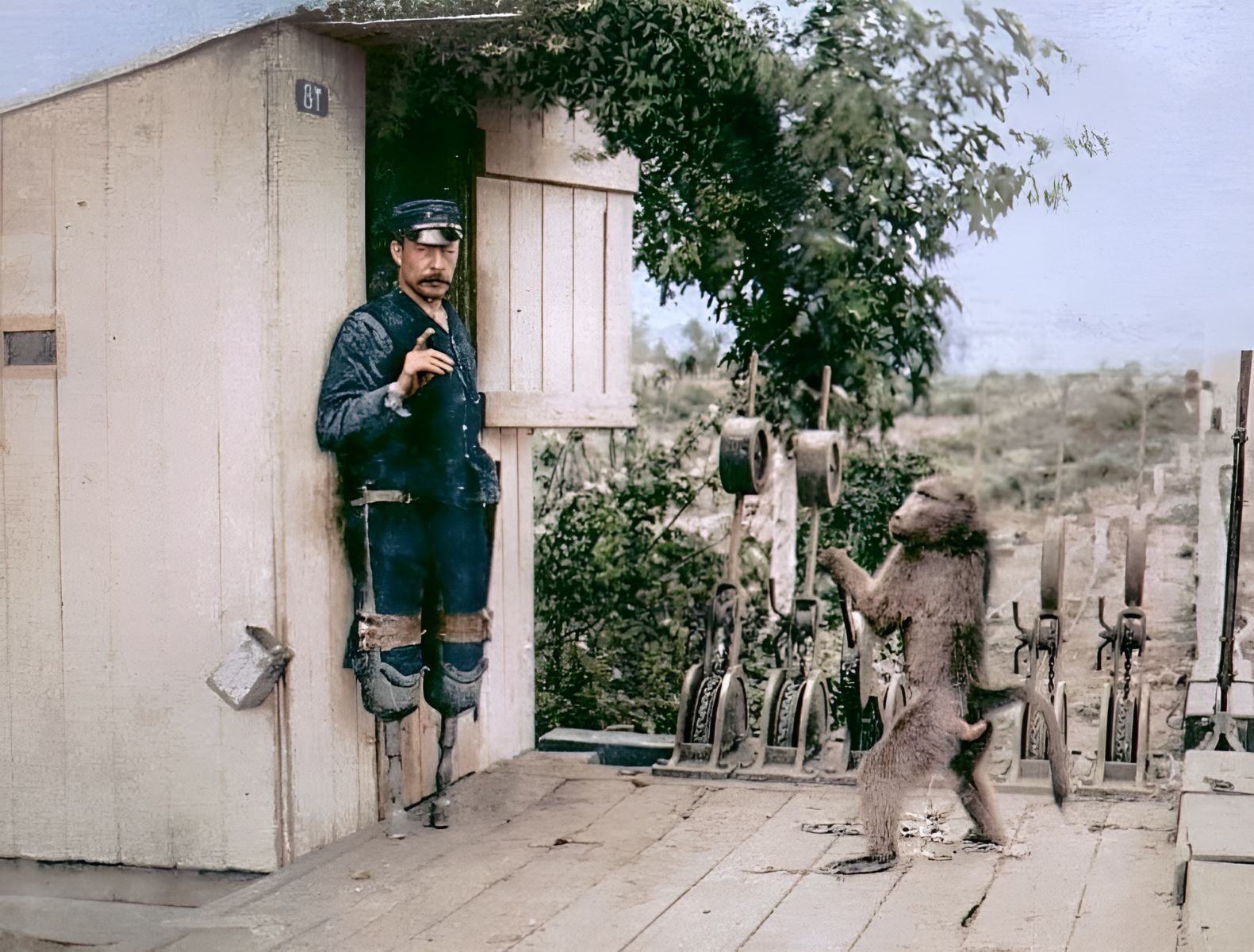
Who was Jack the Baboon? Jack the Baboon wasn't just any primate; he was a railway signalman in South Africa! Born in the late 19th century, Jack became famous for his incredible ability to assist his owner, James Wide, who had lost both legs in an accident. Jack learned to operate railway signals and even helped with other tasks around the station. His story is a remarkable example of animal intelligence and human-animal cooperation. Jack's life wasn't just about work; he also formed a deep bond with James, showcasing the emotional depth animals can have. Ready to learn more about this extraordinary baboon? Let's dive in!
Key Takeaways:
- Jack the Baboon, a Chacma baboon, worked for the Cape Government Railways in South Africa, learning to operate railway signals and even receiving a salary of 20 cents per day and half a bottle of beer each week.
- Jack's incredible story challenges the perception of animals, inspiring studies on animal behavior and cognition, advocating for better treatment of working animals, and highlighting the importance of mutual respect and understanding between humans and animals.
Jack the Baboon: A Unique Railway Worker
Jack the Baboon is one of history's most fascinating animals. His story is filled with surprising and unique facts that will leave you amazed. Let's dive into the incredible life of Jack the Baboon.
-
Jack the Baboon worked for the Cape Government Railways in South Africa during the late 19th century.
-
He was employed as an assistant to a railway signalman named James "Jumper" Wide.
-
James Wide lost both his legs in a railway accident, which led him to train Jack to help with his duties.
-
Jack was a Chacma baboon, a species known for their intelligence and adaptability.
-
He learned to operate railway signals by watching James Wide and mimicking his actions.
-
Jack's primary job was to change the railway signals, ensuring trains moved safely along the tracks.
-
He also helped James Wide with other tasks, such as fetching water and sweeping the station.
Jack's Training and Skills
Jack's training and skills were nothing short of extraordinary. His ability to learn and perform complex tasks made him an invaluable asset to the railway.
-
Jack was trained using a reward-based system, receiving treats for correctly performing tasks.
-
He quickly learned to distinguish between different signal levers and their corresponding actions.
-
Jack's ability to understand and follow commands was so impressive that he rarely made mistakes.
-
He even learned to recognize the sound of approaching trains, allowing him to prepare the signals in advance.
-
Jack's skills were not limited to railway work; he also helped James Wide with personal tasks like pushing his wheelchair.
-
His intelligence and adaptability made him a beloved figure among railway workers and passengers alike.
Jack's Employment and Salary
Jack's employment status and salary were quite unique for an animal. His contributions to the railway were recognized in an official capacity.
-
Jack was officially employed by the Cape Government Railways, making him one of the few animals to hold a job.
-
He received a salary of 20 cents per day, along with half a bottle of beer each week.
-
Jack's salary was paid in the form of food and other necessities, ensuring he was well taken care of.
-
His employment lasted for nine years, during which he never made a single mistake in his duties.
-
Jack's reliability and efficiency earned him the respect and admiration of his human colleagues.
Jack's Legacy and Recognition
Jack's legacy lives on as a testament to the incredible bond between humans and animals. His story continues to inspire and amaze people around the world.
-
Jack's story was widely reported in newspapers and magazines, making him a celebrity of his time.
-
He was featured in several books and documentaries, highlighting his unique contributions to the railway.
-
Jack's life and work were commemorated with a plaque at the Uitenhage Railway Station in South Africa.
-
His story has been used to illustrate the intelligence and capabilities of animals, particularly primates.
-
Jack's legacy has inspired numerous studies on animal behavior and cognition.
-
He remains a symbol of the extraordinary potential of animals when given the opportunity to learn and contribute.
Jack's Impact on Animal Rights
Jack's story has had a lasting impact on the way people view and treat animals. His life serves as a reminder of the importance of compassion and respect for all living beings.
-
Jack's successful employment challenged the perception of animals as mere beasts of burden.
-
His story has been used to advocate for better treatment and recognition of working animals.
-
Jack's life demonstrated the potential for animals to perform complex tasks and contribute meaningfully to human endeavors.
-
His bond with James Wide highlighted the importance of mutual respect and understanding between humans and animals.
-
Jack's story has been cited in discussions about animal rights and welfare, emphasizing the need for humane treatment.
-
His legacy continues to inspire efforts to improve the lives of working animals around the world.
Jack's Final Years
Jack's final years were marked by continued dedication to his work and the bond he shared with James Wide. His story remains a testament to the extraordinary capabilities of animals.
-
Jack continued to work alongside James Wide until his death in 1890.
-
He passed away from tuberculosis, a common illness at the time.
-
Jack's death was widely mourned by those who knew him and appreciated his contributions.
-
His story has been preserved through various historical records and accounts.
-
Jack's life has been celebrated in numerous ways, including books, documentaries, and commemorative plaques.
-
His legacy serves as a reminder of the incredible potential of animals when given the opportunity to learn and contribute.
-
Jack the Baboon remains an enduring symbol of the unique bond between humans and animals, inspiring generations to come.
Jack's Legacy
Jack the Baboon wasn't just any animal. His story is a testament to the incredible bond between humans and animals. Working as a signalman for nine years without a single mistake, Jack proved that animals can be reliable and intelligent partners. His life reminds us of the potential in every creature, no matter how unlikely it seems. Jack's tale isn't just about a baboon working on a railway; it's about trust, companionship, and breaking boundaries. His legacy lives on, inspiring us to look beyond appearances and recognize the unique abilities in all living beings. Next time you hear about Jack the Baboon, remember his remarkable contributions and the lessons he taught us about perseverance and friendship. Jack's story will always be a fascinating chapter in history, showing that sometimes, the most extraordinary stories come from the most unexpected places.
Frequently Asked Questions
Was this page helpful?
Our commitment to delivering trustworthy and engaging content is at the heart of what we do. Each fact on our site is contributed by real users like you, bringing a wealth of diverse insights and information. To ensure the highest standards of accuracy and reliability, our dedicated editors meticulously review each submission. This process guarantees that the facts we share are not only fascinating but also credible. Trust in our commitment to quality and authenticity as you explore and learn with us.


